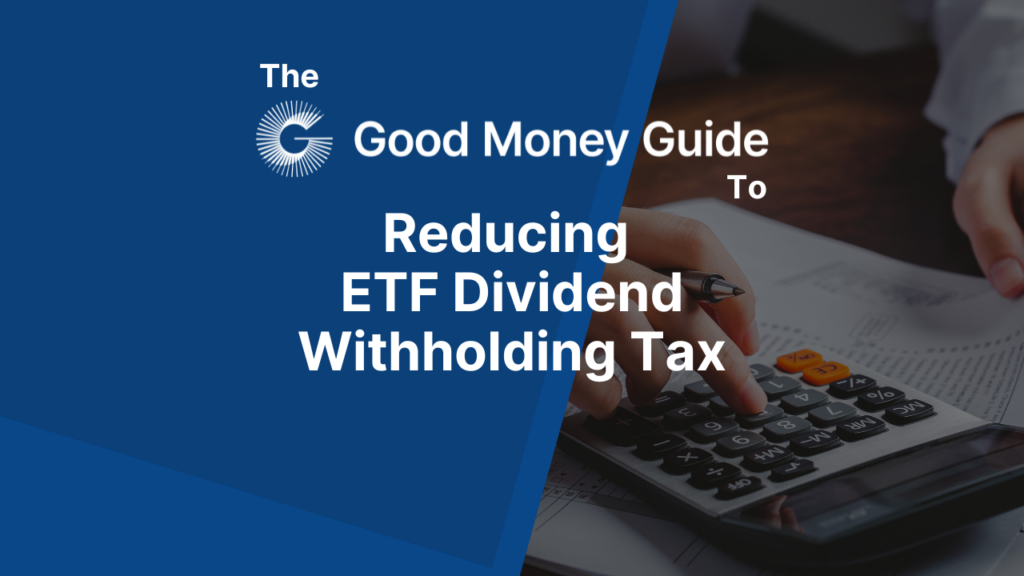One of the most important facets of successful investing is the reduction of your costs over the long term. The logic is quite simple the less you pay away the more you will have to invest. In this guide we discuss how to reduce the amount of withholding tax you pay on ETF dividends.
Thanks to the power of compounding this means the more your low-cost pot will grow over time when compared to one that’s paying higher costs. Investors are getting the message about management fees and admin charges.
For example, The Vanguard S&P 500 ETF (VOO), recently became the world’s largest ETF by AUM. Displacing its long-term (and higher charging) rival the SPDR S&P 500 ETF Trust (SPY) which is managed by US bank State Street.
However, investors often overlook another significant factor that could compromise their performance and returns, in the shape of dividend withholding taxes.
For those investing in international, and geographically diversified ETFs, withholding taxes can directly impact long-term returns, and in some cases reduce their net dividend income by as much as 50.0%.
What are withholding taxes and why must UK investors pay them?
Withholding taxes are levied on dividend income flowing abroad, to allow the domestic government to secure tax receipts that might otherwise elude them.
For example, if withholding taxes weren’t levied in the US, then there would be little to stop large US investors from creating overseas businesses to hold and manage their investments, receiving their dividends gross, and thus avoiding paying domestic taxes on them entirely.
UK shareholders will be well used to the idea that dividend income is taxable.
However, issues arise when dividend income, from abroad is taxed by the overseas authorities, and by local or domestic governments too.
Understanding the three-tiered tax structure
Cross-border ETF investing can create complex tax situations when it comes to the treatment of dividends.
There are three distinct levels of dividend taxes that investors need to be aware of:
Level 1 Tax: Imposed by the country where dividends originate. Most notably, the US government withholds 15-30% of dividends paid to foreign entities, including ETFs domiciled outside the US.
Level 2 Tax: Applied by the ETF’s domicile country when paying dividends to investors in other countries. For European investors. Note though that this can be as low 0.0% when you are investing in Irish-domiciled ETFs.
Level 3 Tax: Levied by the investor’s home country on the investor’s dividend income, typically as part of standard income tax regulations.
If not managed properly, then this trio of taxes can create significant variations in the returns, generated by identical underlying assets.
Meaning that an ETF’s domicile could become an important factor in your investment planning.
An unlevel playing field
Despite being labelled a single market the European investment landscape is anything but, with a myriad of different legal and corporate structures for ETFs. And tax treaties with overseas governments, around funds, that vary between jurisdictions.
Domicile Selection
It’s this distinctly unlevel playing field that can make ETF domicile selection so important when it comes to maximising your returns and limiting your tax liabilities.
For example, Irish-domiciled ETFs can offer a significant advantage for UK investors seeking global or US equity exposure.
This is due to the Republic of Ireland’s tax treaty with the US Government. And the corporate structure of ETFs that are based in Ireland.
Owning an Irish-domiciled ETF can reduce your US withholding tax liability, on dividends, from 30.0% to just 15.0%.
That’s in contrast to ETFs domiciled in say, Luxembourg, Germany, or France, which often can’t access similar tax treaty benefits, due to their corporate and legal structures.
For a UK investor focusing on global equities, via ETFs, this distinction can translate into an immediate uplift in the dividend income, from underlying US investments.
That’s a meaningful advantage when you consider that US equities accounted for 65.75% of the weightings within the MSCI All Country World Index, or ACWI, as of the end of February 2025.
More advanced tax mitigation strategies
Synthetic ETF Structures
Synthetic ETFs employ swap contracts instead of directly investing in securities that make up an equity index or sector. In doing so they effectively circumvent the dividend flow that triggers withholding taxes in the first place. This approach can eliminate Level 1 withholding taxes entirely.
However counterparty risk is inherent in OTC swap-based products, the risk lies between the swap provider and the ETF manager.
For investors who are comfortable with such counterparty risks, synthetic ETFs could offer a way to enhance your returns particularly when combined with domestic tax wrappers like France’s PEA accounts.
However, on the flip side, synthetic ETFs could be subject to tracking errors and or other performance distortions.
Over the years I have found that as a general rule of thumb in finance, the more straightforward or uncomplicated a solution is, the better.
US-domiciled ETFs and tax offsets
Investors with access to US-domiciled ETFs can leverage beneficial tax offset mechanisms in certain European jurisdictions.
In the UK, for example, higher-rate taxpayers can offset the 15.0% US withholding tax paid against their domestic tax liability, effectively reducing the overall tax burden.
Research suggests that for UK investors, in higher tax brackets, this offset could reduce their effective tax rate from 42.6%, with Irish ETFs to 32.50%, with US ETFs, assuming they have completed the proper documentation for the US authorities, namely the IRS W-8BEN forms.
There is, however, another layer of complexity to consider, which is that many US ETFs are not available to UK investors thanks to provisions in MiFID and MiFID II.
UK retail can only invest in ETFs with a UCITs structure, that produces the necessary KIDs or Key Information documents, that the MiFiD legislation requires.
Some US ETF managers don’t believe it’s worth their while to meet these requirements, and their funds are therefore off limits to UK and European retail investors.
However, there are no such restrictions on those investors that qualify as professional clients.
As ever, where tax is concerned, it’s best to seek professional advice, before embarking on a course of action, after all, everyone’s circumstances and tax status are likely to be individual.
Other factors to be aware of
There are two other factors for UK and European investors to be aware of, before pursuing US ETF strategies:
Estate Tax Exposure: US investments exceeding $60,000 can trigger a US estate tax liability of 40% upon an investor’s death.
However, certain countries including the UK and Switzerland benefit from higher exemption thresholds of approximately $5.45 million.
Reporting Requirements: UK investors must verify that US ETFs maintain HMRC reporting status to avoid punitive tax treatment where gains are taxed as income rather than capital.
More notable points
The selection between accumulation ETFs, which reinvest dividends and distributing ETFs, which pay dividends out to investors, does not impact withholding tax liability either. That’s because the withholding tax is levied at the investment level before dividends reach the ETF, regardless of the fund’s subsequent distribution policy.
Unlike equities, US bonds typically do not incur withholding taxes on interest payments. As a consequence, domicile selection is less of an issue for fixed-income ETF investors.
Tax efficient wrappers
Tax-efficient wrappers can offer enhanced protection against dividend taxation.
UK ISAs shield investors from Level 3 (domestic) taxation but cannot prevent Level 1 withholding taxes which are applied at source.
UK SIPPs present a more comprehensive solution, potentially enabling investors to reclaim the 15% US withholding tax, however, this needs to be correctly structured. Normally, your broker, advisor or pension provider will offer the service and handle the necessary documentation.
French PEA Accounts combined with synthetic ETFs can eliminate both Level 1 and Level 3 taxation for French investors.
The message from all of this is to do your homework, think about your strategy and how best to mitigate the impact of withholding taxes on ETF dividend income.





